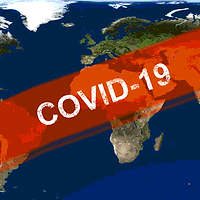The unprecedented coronavirus disease 2019 [COVID-19, named by the World Health Organization (WHO) on February 11, 2020] pandemic reminds us of the horrible previous pandemics, including the H1N1/Spanish Flu pandemic in 1918, killing more than 50 million people; the Asian Flu pandemic in 1957 that killed more than 1.1 million people; and the H1N1 Swine Flu pandemic in 2009, which killed more than 500,000 people. COVID-19 is a disease caused by Severe Acute Respiratory Syndrome coronavirus 2 [SARS-COV2; the virus was named by the International Committee on Taxonomy of Viruses on February, 11 2020. We will use the WHO name for this virus in this article (COVID-19 virus)]. The COVID-19 virus is one member of the coronavirus family; the Severe Acute Respiratory Syndrome of 2003 and the Middle East Respiratory Syndrome of 2012 are among other members. According to the WHO, the COVID-19 virus causes respiratory diseases (a zoonotic disease) in humans; bats are the reservoir for the COVID-19 virus. However, it is believed that the virus jumped the species barrier (through an intermediate animal host, possibly a wild animal or a domesticated wild animal) or a domestic food animal, as there is no direct contact between humans and bats currently. It is also believed that the COVID-19 outbreak started in China (it appears to have been initiated and spread through a wet market in Wuhan city) in December 2019, and then the disease quickly spread (became epidemic) to neighboring countries, including South Korea, Japan, and Singapore. On March 11, 2020, the WHO declared COVID-19 a pandemic since illnesses were severe and spread across the globe. Unlike foodborne gastrointestinal viruses (e.g., norovirus and hepatitis A, which make people ill through contaminated food), the main transmission routes of COVID19 virus (a highly contagious virus) are a) person-to-person contact and b) respiratory droplets (droplet particles are > 5–10 micrometer in diameter) generated when an infected person coughs or sneezes. Airborne transmission (through droplet nuclei (droplet particles are < 5 micrometer in diameter) was not reported for this virus.
March 15, 2020 was the scariest day of my life. On that day (1 day after the Level 3 warning for global travel was released, and 4 days before it was raised to Level 4, where U.S. citizens were advised to return home immediately because of the disruption caused by the global coronavirus pandemic), I was traveling back from Egypt where I spent 2 weeks, on a food safety volunteer assignment, for the USAID farmer-to-farmer program (through Land O’Lakes Inc.), to strengthen the food safety system in Egypt. On my way home, both at the airport and on the airplane, I felt a lot of tension in the air, as everyone was scared of the invisible enemy (COVID-19). According to the Center for Systems Science Engineering at Johns Hopkins University, there were 16 cases of COVID-19 in the U.S. [the U.S. Centers for Disease Control and Prevention (CDC) confirmed the first case on January 21, 2020, for a person in Washington State who returned from Wuhan/China on January 15, 2020] and one case in Egypt when I left the U.S. on February 28.
However, while I was in Egypt, I realized that the virus was spreading like never before. There were about 3,000 and 110 cases in the U.S. and Egypt, respectively, when I left Egypt on March 15. Most of the people I encountered during my travels were not wearing face masks. Measures were taken to determine if I had been infected with the COVID-19 virus. For example, my forehead temperature was checked at the airport when I arrived in Egypt and a health questionnaire was conducted, at the airport, when I arrived in the U.S. Fortunately, I had none of the COVID-19 virus symptoms. The COVID-19 virus symptoms include fever, dry coughing, shortness of breath, runny nose, sore throat, diarrhea, aches and pains, vomiting, and loss of taste and smell. Some people, however, become infected but do not develop any symptoms. More than 80 percent of infected people recover from the disease without treatment.
As of April 26, 2020, there are 2,919,497 cases (including 940,797 in the U.S.; 4,319 in Egypt), 203,607 people have died (including 54,001 in the U.S.; 307 in Egypt), and 822,105 people have recovered worldwide. Older and people with medical problems are more likely to develop serious illness. People with high fever and difficulty breathing should seek medical attention. International organizations including WHO, CDC, and the United Nation’s Food and Agriculture Organization (FAO) have responded to the outbreak to accelerate diagnostics, vaccines, and therapeutics for this novel COVID-19 virus; there are many ongoing clinical trials evaluating potential vaccines and treatments. However, there is still no specific vaccine or treatment for COVID-19.
Not a Foodborne Disease
According to the CDC, WHO, the European Food Safety Authority, FAO, and other public health organizations, there is no evidence that the coronavirus can be transmitted through food or food packaging. However, recent studies concluded that the COVID-19 virus can survive (remain viable) on different surfaces for up to 3 days, under specific conditions such as temperature, relative humidity, and light. The transmission of COVID-19 virus can also happen through contact with contaminated surfaces when people touch these contaminated surfaces and then touch their nose, mouth, or eyes. Thus, theoretically, COVID-19 virus can be transmitted by touching contaminated food or food contact surfaces (including packaging materials) when a healthy person touches these contaminated food or food contact surfaces, and then shortly afterward, touches eyes, mouth, or nose. We know by now that coronaviruses are very stable at low temperatures (survive for up to 2 years at –20 °C); they can survive for up to 2 years in frozen food products. However, coronaviruses are susceptible to high temperatures (70 °C). Also, coronaviruses are susceptible to the most common cleaning and disinfecting agents and procedures. More information is needed regarding the COVID-19 virus, however, so the WHO through the International Food Safety Authorities Network is investigating the potential for persistence of COVID-19 virus on foods and the potential role of food in the transmission of the virus.
In general, the food and agriculture sectors are less affected by COVID-19 pandemic than other sectors. However, food safety can be significantly compromised in the following scenarios: a) increases in food production or processing line speeds to meet the unexpected need during the pandemic, making it harder to control significant food safety hazards; b) transport restrictions, quarantines, and trade disruptions could impose food safety issues, especially with highly perishable and nutritious food such as milk, meat, fish, and fresh produce; c) the absence of inspection or audits; d) infected food workers; e) shortage of labor/workers who run food safety programs, and f) increases in home food delivery/takeout, which can present unprecedented food safety risks and challenges if not properly monitored.
Necessary Precautions:
Governments, international public health, and food safety organizations should a) build and maintain consumer confidence in the safety of their food by providing consistent and transparent messaging; b) enforce public health measures (such as social distancing, testing, wearing face masks, quarantine regime, and lockdown, especially in disease hotspots; c) enforce the adoption and implementation of international food safety management programs and Good Hygiene Practices; d) provide research-based guidelines and policies; e) conduct research and develop vaccines and treatments; f) provide access to telemedicine especially within rural communities; g) consider additional ways to conduct inspection and audit services, taking into account the health and well-being of inspectors, auditors, and the food industry workers; and h) create unified and comprehensive health data systems.
The food industry, during this time of pandemic, has the primary responsibility to ensure that the foods they produce are safe, so it should a) adopt and implement effective food safety management programs, including Hazard Analysis and Critical Control Points; b) adopt and implement “One Health” approach to safeguard human and animal health; c) strengthen hygiene and sanitation practices (e.g., provide training on food hygiene principles and reinforce personal hygiene measures); d) adopt and implement public health measures, including employee testing, physical distancing (at least 2 meters, 6 feet), proper use of personal protective equipment (e.g., masks, gloves, etc.), cough and sneeze etiquette (cough and sneeze into a tissue or your upper sleeve or elbow), prevent infected workers from workplaces, proper handwashing, and avoid direct contact with farm or wild animals; e) adopt additional and more restrictive measures [e.g., restaurants should not serve raw or undercooked food (e.g., rare steaks, raw oysters, sushi, etc.)]; f) establish effective risk communication systems; and g) shutdown processing plants (especially those process products of animal origin) when necessary.
Everyone should a) adopt public health measures (as listed above), especially during food shopping; b) properly wash fresh fruits and vegetables under running tap water; b) not eat raw or undercooked food of animal origin; c) properly wash and/or sanitize hands before and after touching food or food packaging; d) properly clean and sanitize food contact surface before and after use; e) follow the four key steps of food safety (clean, separate, cook, and chill); f) clean lids of canned food before opening; g) refrigerate or freeze perishable food within 2 hours of purchasing; h) properly clean and sanitize kitchen counters; and i) handle raw animal products with care to avoid cross-contamination.
The main purpose of this article is to highlight the importance of food safety, hygiene, and sanitation measures during COVID-19 pandemic so safe food can be provided to consumers around the globe, especially the most vulnerable in both developed and developing countries.
Barakat Mahmoud, Ph.D., is an international food safety expert with 30 years of experience in food safety. He has provided technical assistance in food safety in several developing countries in Africa, Asia, Central America, the Middle East, and the Caribbean.
Resources
wwwnc.cdc.gov/eid/article/26/7/20-0885_article
www.arcgis.com/apps/opsdashboard/index.html#/bda7594740fd40299423467b48e9ecf6
www.who.int/publications-detail/covid-19-and-food-safety-guidance-for-food-businesses
www.who.int/docs/default-source/coronaviruse/situation-reports/20200221-sitrep-32-covid-19.pdf?sfvrsn=4802d089_2
www.nejm.org/doi/pdf/10.1056/NEJMc2004973
www.sciencedirect.com/science/article/pii/S001650852030281X?via=ihub
www.who.int/emergencies/diseases/novel-coronavirus-2019/situation-reports
ec.europa.eu/food/sites/food/files/safety/docs/biosafety_crisis_covid19_qandas.pdf
www.unido.org/news/unido-supports-member-states-addressing-implications-covid-19-food-safety-and-food-business-operations
www.fda.gov/food/food-safety-during-emergencies/shopping-food-during-covid-19-pandemic-information-consumers
www.mdpi.com/2304-8158/9/4/523/htm




